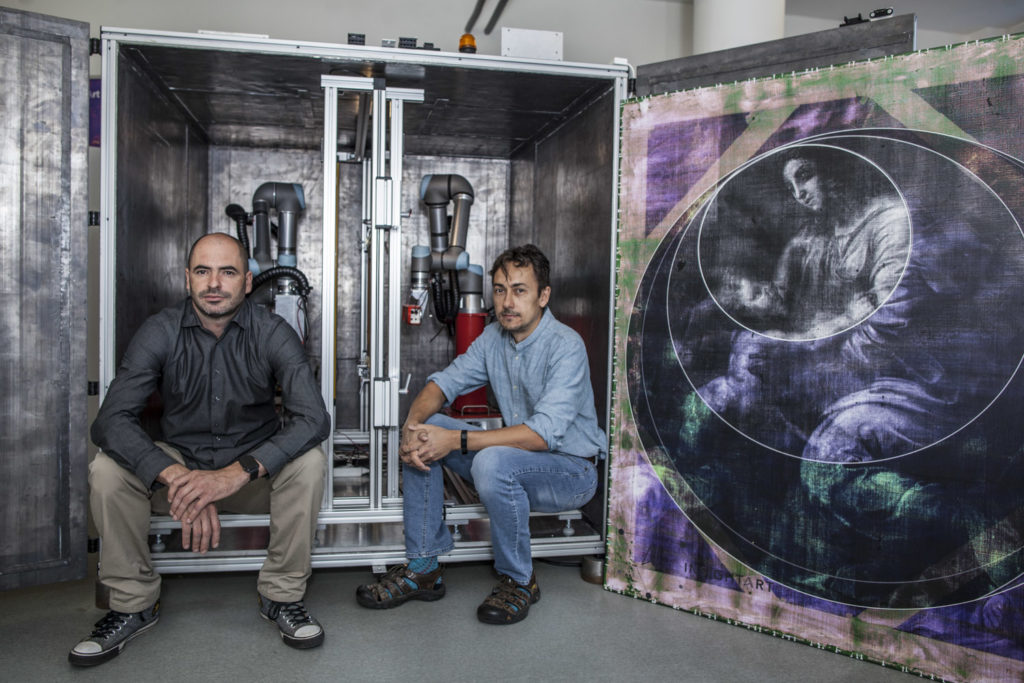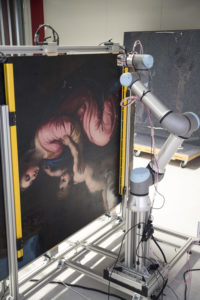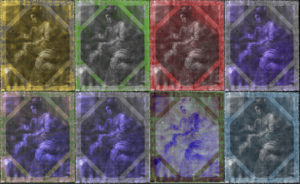InsightART helped to analyse the lost Raphael’s painting
 InsightART participated in the study of the lost Raphael’s painting, the artwork was restored by one of the founders of InsightART, Jiří Lauterkranc, and his colleague Jiří Živný. The journey of Madonna with Child continues.
InsightART participated in the study of the lost Raphael’s painting, the artwork was restored by one of the founders of InsightART, Jiří Lauterkranc, and his colleague Jiří Živný. The journey of Madonna with Child continues.
The Renaissance artist Raffaello Santi – also known as Raphael – may have died 500 years ago, yet the experts are still discovering new aspects of his art. His Madonna and Child painting has a rich history encompassing some of Europe’s great historical figures, as well as violent fights and expensive art deals. Over the centuries, the painting has also seen its authenticity repeatedly, albeit unjustly, questioned. The unique work has been researched by leading experts from around the world. One of the technologies used was InsightART’s x-ray scanner, which uses detectors equipped with CERN chips, state-of-the-art imaging technology that can provide an unprecedented amount of information about works of art.
InsightART’s RToo robotic scanner is one of the first x-ray machines specialized in art investigation. The scanner had already been used to unveil a painting signed Vincent van Gogh. This time around, it has helped explore the secrets of the lost Raphael. The machine uses a particle detector developed at CERN for the purposes of space exploration, manufactured by the Czech company ADVACAM.
„This technology – which is also used to measure radiation at the International Space Station – is capable of detecting and counting single photons, as well as establishing their exact wavelength,“ explains Josef Uher, a physicist and InsightART’s CTO. „While the standard x-ray machine only creates a black and white image,“ continues Uher, „RToo provides „color“ – or spectral – x-ray images, which allow the materials to stand out on the basis of their elemental composition. Besides making use of the special robotic platform, supplied by another Czech company, Radalitica, this is the key advantage of the RToo x-ray machine“.
„The artwork was scanned using spectral x-ray radiography. The resulting scans revealed in detail the internal structure of the painting. Based on spectral x-ray imaging, it could be established that the overall concept of the painting was thought through in great detail – from the foundation layers to the final glazes.” says Jiří Lauterkranc, one of the restorers and our co-founder.

History of the painting
The Madonna and Child painting signed and dated „Raphael Urbinas Pingebat MDXVII, Roma“ was painted by Raffaello Santi in 1517 at the commission of Pope Leo X. The piece was to be placed on the altar of the Sanctuary of the Holy House of Loreto. One year later, Raphael used the same motive for his Great Holy Family painting which the Pope donated to the French royal family, and which later became part of the Louvre collection. Meanwhile, Raphael’s 1517 Madonna and Child remained in the Vatican until 1798, i.e. until the pontificate of Pius VI. After the occupation of Rome by one of Napoleon’s armies, the painting was taken to Paris where it became part of Napoleon’s collection. After Napoleon’s fall in 1813, the painting became property of the French Bourbon king Louis XVIII, who in turn sold it to Charles Bosanquet, the first Vice-Chancellor of Newcastle University. Bosanquet’s family owned the painting until 1928, when it made its way back to France thanks to Dr. Hahn, an art dealer. In Paris, the painting was acquired by Ernst Beleuer who brought it to Prague and subsequently sold it to Otomar Švehla. Švehla offered the painting to the Czechoslovak President’s Office, as well as to Third Reich Chancellor Adolf Hitler. However, neither transaction took place and after Švehla’s death the painting fell to his wife, Emilie Švehlová. In 1992, the painting found itself in Slovakia where it was bought by a Czech entrepreneur who exported it from the country.
 Since then, the Madonna and Child was studied by several world-renowned experts and Raphael specialists, such as Professors Baldini, De Vecchi, Chiarini, Marabotti and Pedretti. Czech experts also took part in the process and it was Professor Raymond Ondráček who – on the grounds of previous investigations – started restoring the painting in 2002. Later, Professor Ondráček’s work was continued by another two Czech fine art restorers, Jiří Lauterkranc a Jiří Živný. The restoration, concluded only in 2019, took place under the scrutiny of an international advisory board composed of experts from Italian and Czech leading institutions. The board included, among others, restorers Lorenza d’Alessandro, Antonio Forcellino and Paolo Violini, as well as art historians Msgr. Timothy Verdon and Jiří Fajt. The last part of the process took place in 2019 and included the reviewing and updating of all previous analyses and investigations of the painting. In order to finetune the restoration strategy and process, a series of analyses was repeated, which took advantage of the latest technology available. Some of the analyses also focused on the circumstances under which Raphael’s Madonna and Child came to light, as well as on its relation to the Great Holy Family, its sibling painting from 1518. These examinations mainly included the exact identification of the under-drawing, the technological construction and the internal structure of the painting. It was at this stage that the Czech company InsightART and its robotic scanner RToo were invited to be a part of the project.
Since then, the Madonna and Child was studied by several world-renowned experts and Raphael specialists, such as Professors Baldini, De Vecchi, Chiarini, Marabotti and Pedretti. Czech experts also took part in the process and it was Professor Raymond Ondráček who – on the grounds of previous investigations – started restoring the painting in 2002. Later, Professor Ondráček’s work was continued by another two Czech fine art restorers, Jiří Lauterkranc a Jiří Živný. The restoration, concluded only in 2019, took place under the scrutiny of an international advisory board composed of experts from Italian and Czech leading institutions. The board included, among others, restorers Lorenza d’Alessandro, Antonio Forcellino and Paolo Violini, as well as art historians Msgr. Timothy Verdon and Jiří Fajt. The last part of the process took place in 2019 and included the reviewing and updating of all previous analyses and investigations of the painting. In order to finetune the restoration strategy and process, a series of analyses was repeated, which took advantage of the latest technology available. Some of the analyses also focused on the circumstances under which Raphael’s Madonna and Child came to light, as well as on its relation to the Great Holy Family, its sibling painting from 1518. These examinations mainly included the exact identification of the under-drawing, the technological construction and the internal structure of the painting. It was at this stage that the Czech company InsightART and its robotic scanner RToo were invited to be a part of the project.


